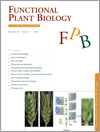
Functional Plant Biology
Volume 46 Number 11 2019
In nature, the evolution of plant populations is a slow process and thus, it’s difficult to observe through experimental simulations. We increase the accumulation of carbohydrates in Alhagi sparsifolia by long-term clipping, to observe the evolution of A. sparsifolia under such a condition. It was found that the degree of lignification of A. sparsifolia was increased after long-term clipping, plants have a tendency to evolve from herbs to shrubs. This study provides a new method to observe plant evolution quickly.
To predict the function of forest ecosystems in the future it is necessary to explore the responses of functional traits to environmental changes. The variations in water use and leaf traits with addition of nitrogen differed among tree species, except water use efficiency, which remained constant. Our findings indicate that the experimental approach for simulating atmospheric nitrogen deposition needed to be modified, and that increased nitrogen availability could affect the species composition of forests.
Drought is one of the main abiotic stresses of plants, with far-reaching ecological and socioeconomic impacts, especially in perennial food crops such as Prunus spp. This study provides novel insights into the root proteome changes in combination with the leaf physiological and biochemical responses in the hybrid rootstock ‘Garnem’. These findings enhance the existing knowledge on the root proteomic changes in response to drought, offering us new drought-tolerance breeding approaches.
FP19002Anatomical root responses of rice to combined phosphorus and water stress – relations to tolerance and breeding opportunities
 , Elke Vandamme, Allen Lupembe, Leah Mwakasege, Kalimuthu Senthilkumar, Khady N. Dramé and Roel Merckx
, Elke Vandamme, Allen Lupembe, Leah Mwakasege, Kalimuthu Senthilkumar, Khady N. Dramé and Roel Merckx
Rice is one of the world’s most important cereal crop, but yields are often constrained by droughts and low soil fertility. We found that differences in specific root characteristics explain the plant performance under drought and/or low soil fertility. Some of these traits can be targeted by breeding efforts, and others can be exploited by specific farm management, focusing on water in particular.
Resource allocation to the developing spikelets, florets, and grains during yield formation is still an unresolved research endeavour in most cereal crops. We developed wheat germplasm with non-canonical spikelet architecture whereupon two spikelets share one rachis node. Comparisons in the resource allocations between primary and secondary spikelets revealed that secondary spikelets perceived less assimilate most likely as an effect of vascular architecture.
FP19041 Abstract | FP19041 Full Text | FP19041PDF (649 KB) | FP19041Supplementary Material (869 KB) Open Access Article
This is an integrative approach to a legume–rhizobia–virus triple interaction, which shows the capacity of rhizobia to induce both growth and immunity. The biochemical, physiological and molecular characterization of soybean–Bradyrhizobium japonicum–soybean mosaic virus interaction, showed the plant growth-promoting and immunity-inducing effects given by rhizobia inoculation. These results contribute towards more environmentally-friendly agriculture.
FP19023Genome-wide identification of the glutathione transferase superfamily in the model organism Brachypodium distachyon
To generate stress-tolerant crops it is necessary to understand the plants’ defence mechanisms and identify the attendants of these processes, e.g. the genes involved in the stress responses and their phylogenetic variability. The active candidates of these processes are detoxification enzymes such as glutathione transferases (GSTs), which, according to our results, showed higher expression levels or fast induction under osmotic stress in purple false brome. These GST coding sequences, belonging to tau and phi classes (BdGSTF8, BdGSTU35 and BdGSTU42) in Brachypodium lines, may account for high tolerance under soil drought.




